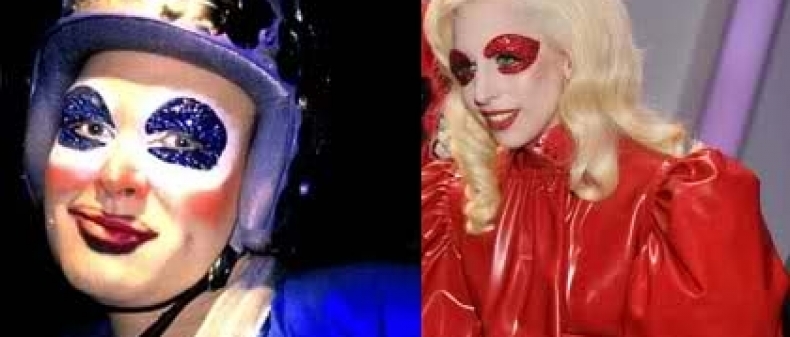
I’ve never understood the appeal of Lady Gaga. I like pop music and enjoy listening to her songs when I’m pre-drinking with my laptop, but there’s something about her persona I find chilly and off-putting. When I saw her perform live during the Oxegen Music Festival in Ireland she had almost no rapport with the audience. To be fair, the attendees were Wellington-clad mud-caked day drunk Irish youths who didn’t have much patience for her high art posturing. It was 2009, just before Gaga made it huge and could rely on the idolatrous love of her legion of “Little Monsters.” Katy Perry, performing at the same festival, came out from the stage and got soaked in rain along with the audience. Lady Gaga kept us at a distance.
I was only half-interested when my friend Erica invited me to Of A Monstrous Child: A Gaga Musical, a cabaret-inspired play written by Alistair Newton and currently playing at Buddies in Bad Times Theatre. I can’t shake the feeling that the former Stefani Germanotta doesn’t deserve half the amount of intellectual discussion she’s provoked. But then I read the play’s narrator would be none other than walking artwork Leigh Bowery (more precisely, an actor playing him). Now that excited me.
“Leigh Bowery was an Australian performance artist, club promoter, actor, pop star, and fashion designer based in London,” Bruce Dow as Bowery declared at the play’s beginning, reading from his own Wikipedia profile. “Bowery is considered one of the more influential figures in the 1980’s and 1990’s London and New York art and fashion circles…” Dow paused. “One of?!”
He wore a baggy, misshapen grey ensemble, eyeglasses with creepy painted dot pupils, and streaks of ink dripping down his bald head. We soon learned why Bowery’s costume was so lumpy. Recreating his famous “Birth Show,” Bowery lay back and Kimberly Persona as Lady Gaga emerged from between his legs, microphone in hand, ready to sing.
The show isn’t so much about Lady Gaga as about the idea of Lady Gaga, with pop music and conceptual art figures called upon to provide their two cents. You have to appreciate a playbill that under the name of comedian Gavin Crawford reads “Bjork, Cher, Camille Paglia, Marina Abramovic, Andy Warhol, Quentin Crisp.” Newton is perhaps too faithful to Gaga’s intellectual forebears and critics as he allows the characters to speak long paragraphs of theory.
As a Gaga skeptic I caught myself nodding along with Paglia’s stiletto-like cut up of the singer: “How could a figure so calculated and artificial, so clinical and strangely antiseptic, so stripped of genuine eroticism have become the icon of her generation? Can it be that Gaga represents the exhausted end of the sexual revolution?… Drag queens, whom Gaga professes to admire, are usually far sexier in many of her over-the-top outfits than she is.”
Where is Gaga to defend herself? Not in this play, where she mostly appears singing and dancing or silently posing. Sometimes she appears as a disembodied head projected on a screen high above the stage. This technique sucks the warmth out of even the most relatable, sympathetic Gaga anecdote (a retelling of a fan’s meeting with her during which she read a confessional letter he wrote for her).
But I need to stop seeking warmth and authenticity from Lady Gaga. One of the points of the play seems to be that there is no “real” Lady Gaga hiding behind the wigs and sunglasses, that the line between Stefani Germanotta and her alter ego has evaporated, there is no man behind the curtain manipulating the Wizard. As the play quotes Gaga as saying, “Fame is a lie but your fans make it true.”
Which is all fine and dandy, but a question remains–why does Lady Gaga inspire such devotion from her fans? If she is a dispassionate mask of a performance piece, why do young gay men in particular feel so attached to her? And why is it believable that her influence has prevented some queer kids from taking their lives?
I got a chance to pose this question to the playwright after the show.
“Gay men have always liked female performers with a sense of the theatric, of drama,” he answered. “Also, it helps when there’s an element of tragedy, like with Judy Garland.”
“Yes, but you didn’t compare Gaga to Garland,” I said. Despite her neurotic jitters and campy flounces, Garland always read as authentic, wearing perhaps too much of her heart on her sleeve. “You compared her to Leigh Bowery and Marina Abramovic and Yoko Ono…”
“Because that’s who Gaga compares herself to,” Newton explained. “That’s who she says have influenced her.”
In some ways, Newton didn’t have to have Gaga speak for herself–the whole play was based on her self-presentation as a performance artist. Near the end, Newton has Gaga quote passages from Stefani’s undergraduate papers on nudity and the deformed body. It’s the closest we get to Gaga explaining herself, but I couldn’t follow most of it because it’s been years since I’ve read academic-ese.
After the play, my friend Erica and I ruminated about why we still didn’t ‘get’ Gaga. Perhaps, Erica theorized, it wasn’t that Lady Gaga didn’t understand all the art theory she claims to be influenced by. Perhaps she understands it too much.
“She’s like an art student who became a pop star,” Erica said. “Everything’s planned out. She knows exactly what she’s doing. It feels contrived because it is contrived.”
“Without the imperfections of just winging it,” I added, “You can explain it all away and it disappears.”
At home that night, I watched the documentary The Legend of Leigh Bowery on Youtube. Watching Bowery by yourself late at night is not for the faint of heart. He scares me a bit. Starting as a designer, he eventually realized that he didn’t want anyone to wear his clothing but himself. His tall, fleshy body became his canvas and he turned himself into a beautiful and disturbing piece of art. He painted his skin blue like a Hindu god, or drew an enlarged red clown’s mouth over his real one. He wore Victorian bustles of gingham or futuristic S&M outfits of plastic. He pierced safety pins in his cheeks or painfully taped up his genitals behind a mirkin.
Decades before Kim Kardashian, he arrived at an art gallery in full-bodied floral dress resembling a sofa. How great that, three decades after he started his making them, his creations still disturb. There was always a dark side, always an element of perversion. His criticism of the work of others was often, “Where’s the poison?”
And yet, when you watch clips of Bowery dancing at club Taboo or accosting shocked onlookers on the street, he looked comfortable despite the insanity of his clothing. When I see Lady Gaga interviewed in a flamboyant hat and ridiculous fake eyelashes, I resent not the way she’s dressed, but that she looks uncomfortable and unsure of herself. Even when cracking Wildean witticisms of dark humour, Bowery held himself with a confidence that forced you to take him seriously. I like to think it’s because his costumes weren’t actually costumes, but a reflection of who he was. Unlike most, he simply had the bravery and gall to wear his monstrousness on the outside.
____
Max Mosher writes about style for Toronto Standard. You can follow him on Twitter at @max_mosher_.
For more, follow us on Twitter @TorontoStandard or subscribe to our newsletter.














